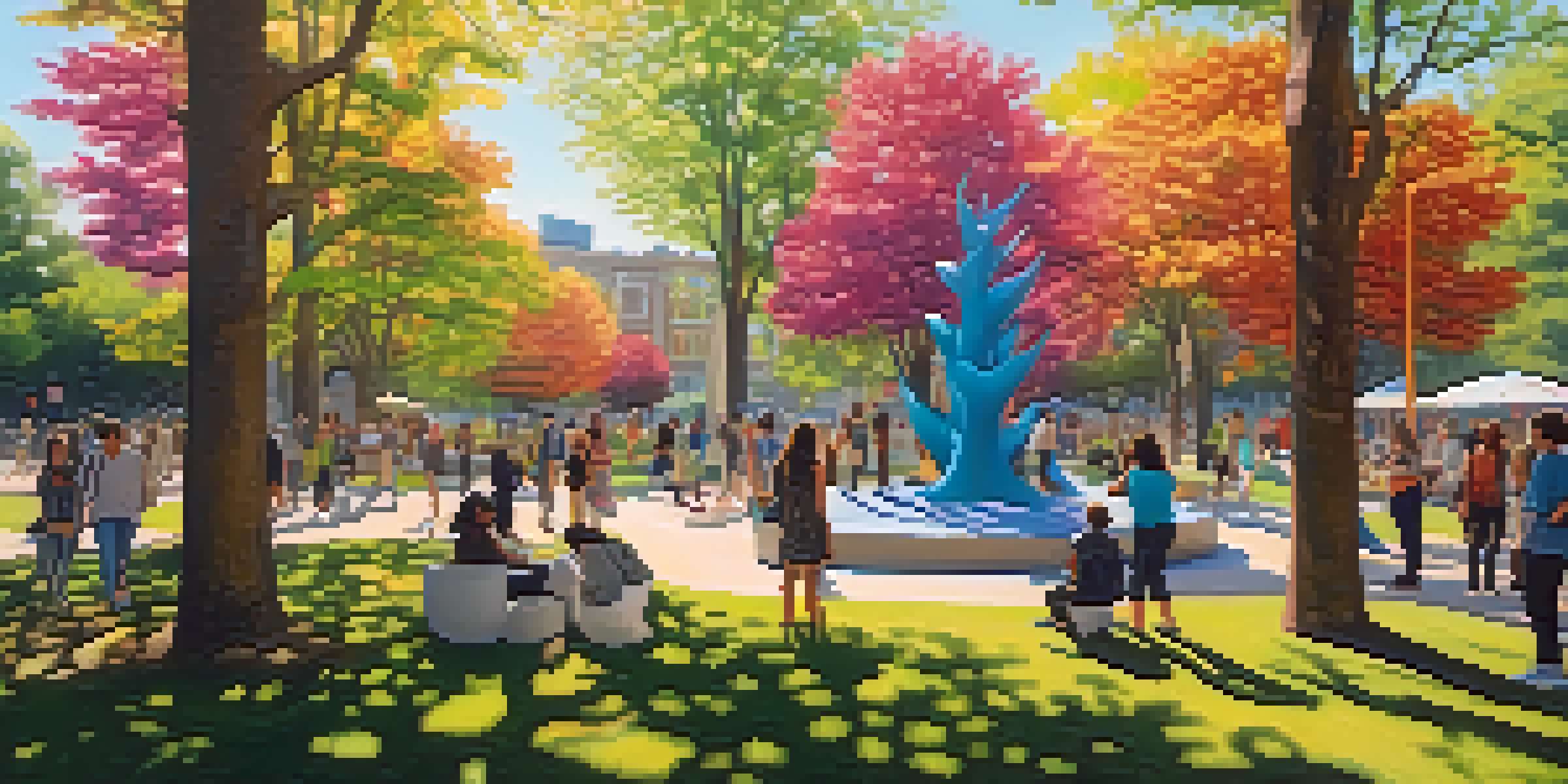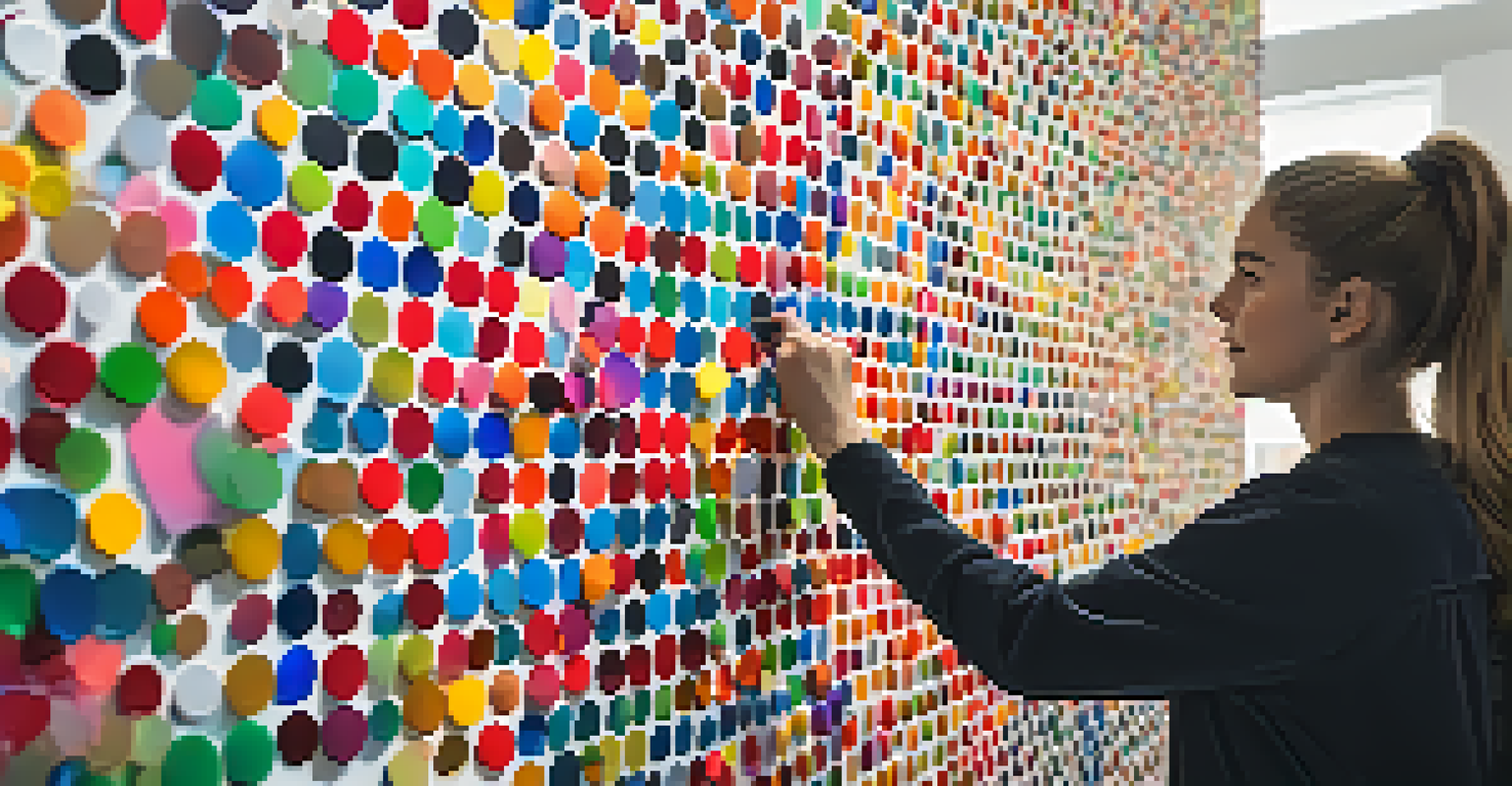Interactive Art: Engaging Audiences Through Innovation

What is Interactive Art and Why Does It Matter?
Interactive art is a dynamic form of creativity that invites viewers to engage and participate. Unlike traditional art, where the audience is a passive observer, interactive art transforms spectators into active participants, making the experience personal and immersive. This shift in engagement is significant as it can foster a deeper emotional connection to the artwork.
Art is not what you see, but what you make others see.
By encouraging interaction, artists can create a dialogue with their audience, prompting them to reflect on their own experiences and interpretations. This collaborative nature not only enhances the enjoyment of the art but also broadens its impact, reaching a more diverse audience. In a world increasingly driven by technology, this form of art resonates well with contemporary culture.
Ultimately, interactive art challenges the conventional boundaries of artistic expression, allowing for innovation and exploration. It opens up a space for creativity where viewers aren’t just spectators but co-creators, redefining the relationship between art and its audience.
The Role of Technology in Shaping Interactive Art
Technology plays a pivotal role in the evolution of interactive art, providing tools that enable astonishing creativity. From virtual reality (VR) to augmented reality (AR), artists can create experiences that transport viewers to new realms. For instance, VR installations can immerse viewers in entirely different worlds, making them feel as if they are part of the artwork itself.

Moreover, technology allows for real-time interaction, where the audience's actions can directly influence the art. This could range from changing colors and sounds to altering the very structure of the piece. Such responsive elements not only engage the audience but also personalize the experience, as each interaction can yield different outcomes.
Interactive Art Engages Audiences
Interactive art transforms viewers into active participants, fostering deeper emotional connections and enhancing the overall experience.
As technology continues to advance, the possibilities for interactive art are boundless. Artists can experiment with new mediums and methods, pushing the envelope on what art can be. This synergy between art and technology invites audiences to explore and engage in ways they never thought possible.
Examples of Groundbreaking Interactive Art Installations
One notable example is 'The Obliteration Room' by Yayoi Kusama, where a completely white room transforms as visitors add colorful dot stickers. This immersive experience encourages participation and collaboration, allowing the audience to leave their mark on the artwork. It beautifully illustrates how collective interaction can create a vibrant tapestry of creativity.
The role of the artist is to make the world a more beautiful place by engaging the audience in a dialogue.
Another striking installation is 'The Infinity Room,' which uses mirrors and lights to create an illusion of endless space. Visitors step inside and are enveloped in a mesmerizing environment, where their presence becomes part of the artwork. This unique experience not only captivates but also instills a sense of wonder, making it memorable for all who participate.
These examples highlight the diverse ways interactive art can engage audiences. Whether through participation or sensory experiences, they demonstrate the powerful impact of innovation in art, showcasing how creativity can unite and inspire.
The Psychological Impact of Interactive Art
Interactive art can have profound psychological effects on participants, fostering a sense of belonging and community. Engaging with art in this way can evoke emotions, spark creativity, and even encourage self-reflection. When individuals interact with art, they often feel a deeper connection not only to the work itself but also to those around them.
Moreover, the act of participating can reduce barriers, allowing people from different backgrounds to come together through a shared experience. This communal aspect can be particularly powerful in public spaces, where art becomes a catalyst for conversation and connection. It shows that art is not just for the elite; it’s for everyone.
Technology Drives Artistic Innovation
Advancements in technology, like VR and AR, enable artists to create immersive experiences that encourage real-time audience interaction.
Furthermore, interactive art can serve as a therapeutic tool, helping individuals express themselves and process emotions. Whether through movement, sound, or visual interaction, these experiences can be cathartic, highlighting the importance of art in mental well-being.
The Future of Interactive Art: Trends to Watch
As we look ahead, several trends are emerging in the realm of interactive art. One prominent trend is the integration of artificial intelligence (AI) to create works that evolve based on audience interaction. This fusion of creativity and technology invites a new level of engagement, where the art can learn from its viewers and adapt over time.
Additionally, there’s a growing emphasis on sustainability within interactive art, with artists using eco-friendly materials and techniques. This not only aligns with global environmental concerns but also encourages audiences to reflect on their relationship with nature. Art becomes a platform for discussing critical issues while engaging the public.
Lastly, the rise of digital platforms is making interactive art accessible to broader audiences. Virtual exhibitions and online installations allow people from all over the world to experience and engage with art in innovative ways. This democratization of art is an exciting development, ensuring that creativity knows no bounds.
How to Experience Interactive Art Locally
Experiencing interactive art is easier than ever, with many cities hosting installations and events. Check local galleries and museums, as they often feature interactive exhibits that invite participation. These spaces can provide opportunities to engage with art in a way that goes beyond just looking.
Another great way to discover interactive art is through art festivals, which frequently showcase innovative pieces. From immersive installations to performance art, these events present a diverse range of experiences that can spark your creativity. Attending such gatherings can also introduce you to like-minded individuals who share your passion.
Community Shapes Art's Impact
Engaging communities in the creative process enriches the art and strengthens social bonds, making it more inclusive and representative.
Finally, don’t forget to explore public spaces; many cities are incorporating interactive art into parks and community areas. These works are designed for everyone to enjoy and can often be found in unexpected places. So, keep your eyes peeled for these engaging pieces that invite you to play and participate!
The Importance of Community Engagement in Interactive Art
Community engagement is vital in the realm of interactive art, as it helps foster a sense of ownership and pride in local culture. When artists involve community members in their creative process, the artwork reflects shared values and stories, creating a deeper connection. This collaborative spirit not only enriches the art but also strengthens community bonds.
Moreover, engaging the community can lead to diverse perspectives and ideas, making the art more inclusive and representative. When different voices are heard, the resulting artwork can resonate with a broader audience, inviting more people to participate. This inclusivity enhances the overall experience for everyone involved.

Ultimately, community engagement ensures that interactive art remains relevant and impactful. By forging connections between artists and audiences, it creates a dynamic environment where creativity thrives, making art a powerful vehicle for social change.